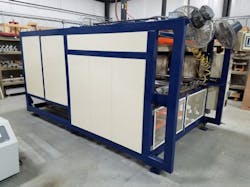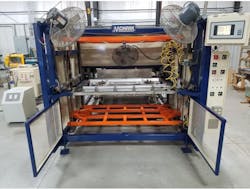How to Thermoform Heavy-Gauge Complex Parts, from Material Selection to Custom Tooling
In many instances thermoforming of heavy-gauge plastics (thicknesses of 1.5 mm (.060 in.) or greater) is the technology-of-choice for manufacturers and new product designers. Using this process of vacuum forming heated plastic sheets is ideal for many products and components required by aerospace, automotive, medical, manufacturing and countless other industries. A wide variety of heavy-gauge plastic materials are available for this process, many of which can be used for complex parts that demand tight tolerances, intricate geometries and special properties such as fire resistance. Heavy-gauge thermoformed plastics are also a practical solution for many larger parts, such as automotive dashboard sections, refrigerator door shelving and snowmobile body panels.
At the same time, thermoforming prototypes and tooling are often developed more quickly than many conventional molding methods and can be performed through a number of economical processes.
If customers are too self-reliant when they design parts for the heavy-gauge thermoforming process, these same attributes may also be the source of confusion, wheel spinning, and the expenditure of unnecessary costs. What is often needed is a collaborative process that includes thermoforming specialists early in the design of the products that will be formed.
Get design support early
“In my experience, it is highly beneficial for the customer’s design engineers to collaborate with their thermoforming vendor early in the process,” says Jesse Hahne, design engineer at the Center for Advanced Design (CAD), Elk River, Minn. “The vendor, Alpha Plastics, can help validate the geometry and features of the product design, confirm or assist with material selection, determine how tooling should be developed, provide prototypes quickly and economically, and of course confirm the best process for meeting production volume requirements.” CAD is a design firm that focuses on the plastics industry, including design for vacuum forming, rotational molding, injection molding and blow molding.
Hahne, a highly experienced design engineer, consults with many in-house engineers of clients as well as with thermoforming specialists and the molders of different plastic forming technologies. He has a close relationship with Alpha Plastics (www.alphaplastics.net), a design and fabrication specialist located nearby in Minneapolis, Minn. In addition to heavy-gauge thermoforming, the company offers pressure forming and traditional vacuum forming services.
“In our eyes, Alpha Plastics has carved out a niche for complex, hard-to-form, heavy gauge thermoformed products,” Hahne explains.
Confirm the process
Jeff Walczak, Alpha Plastic’s executive vice president, says that in some cases he receives requests to evaluate the use of thermoforming a product that might best be produced by another process. “I tell them, ‘Yes, it’s a well-designed part, but pressure forming may be a more appropriate process for producing it,” Walczak says. “So, it’s easy to see why it is vital to get support from a supplier’s technical staff early in a project, especially if they are familiar with various forming and molding technologies. This can be very valuable in helping the customer validate that they are considering the right process.”
For example, because Walczak’s firm also offers pressure forming of heavy-gauge plastics, he can also handle projects most suitable for that process as well. He describes pressure forming as similar to the vacuum forming process, but with specific tooling that can produce parts with much greater definition. In instances where volumes are relatively low, pressure forming may be a viable alternative to much more expensive injection molding.
With both thermoforming and pressure forming projects, Walczak assists customers from design to materials selection, tool development, prototyping or 3D modeling and production.
Check tooling specifications
It is often vital that design engineers validate tooling with thermoforming specialists, particularly when the project includes design complexities. These could include such requirements as undercuts, the use of breakaway molds, two-piece products involving manifolds or ductwork, or products that require special trimming or surface finishes. Forming complexities can be problematic for some thermoforming shops. Walczak says they are often achievable, but may require modifications in tooling that could result in cost savings.
“With thermoforming you have much greater flexibility with tooling than you have with technologies such as blow molding or rotational molding,” says CAD’s Hahne. “For example, for smaller projects you can 3D print and test the tool. If a large tool is required, then you build a wood pattern and produce test parts from it, then make changes to the pattern before you finalize the tool design. This technology is so forgiving and flexible it really works well for larger products like snowmobile body panels.”
Hahne adds that for many projects, a 3D test sample or product run from a wood pattern may suffice as a prototype for the project.
That tooling flexibility of the thermoforming process enables Alpha Plastics to work with a wide range of sizes, using plastic materials from .010 to .45 in. thick to produce parts as large as 5 x 8 ft, with a maximum draw or depth of 30 in., with draw ratios to select the proper base thickness and forming process.
Validate material selection
While a wide variety of plastic materials are appropriate for thermoforming, it is wise to work with thermoforming specialists to determine the availability of materials, volume requirements, and the ability of materials to meet design requirements. Materials such as ABS and polyethelenes are suitable for many projects, but others require more demanding properties that are available with more advanced materials including TPOs (thermoplastic polyolefins), polycarbonate, and Kydex.
“Any of a number of factors could come into play when you are considering material selection for your products or components,” Walczak explains. “Those could include the finish, impact resistance, fire resistance or scratch resistance and many others.”
Walczak says these advanced materials have properties that are excellent for many specific applications. For example, polycarbonate when a tough, transparent product is needed; TPOs for stability; Kydex for such as its cleanability, so that graffiti or scuffs and scratches may be removed from the surface of the material, as well as excellent chemical and flame retardant properties
“However, some of these materials may not be practical or even available for low-volume projects,” Walczak advises. “In those cases secondary processes may become part of the solution, whether painting or silk-screening or other cosmetic solutions. That’s one of the reasons why it’s important to consult with an experienced thermoforming vendor about material selection early in the design process.”
Start-to-finish feedback
Several years ago Kent Olson, vice president of Packaging Plus, Inc. (Rogers, MN) had a special project for a large medical company that required heavy-gauge thermoforming. The product was a tray composed of R-63, a black, conductive material that is static dissipative that would be used in a clean room.
“The tray is a unique design that my company worked out with Alpha Plastics,” Olson explains. “The tolerances needed to be very precise, within thousandths of the medical company’s requirements.”
Olson says he has required additional sizes of the medical trays over the years, as well as a catch basin project that required a fairly deep draw of approximately 12 inches.
“Working with the thermoforming vendor, Alpha Plastics, involved a highly comprehensive process,” Olson says. “At the beginning of the project I sat down with their technicians and went through the specific requirements. They then provide the necessary drawings, and after review, they created a prototype for the customer. After that was approved, we went into production. But it was very significant that the vendor kept me informed all along the way. That was one of the keys to our success.”
For more information, contact Alpha Plastics, Inc., 9315 Evergreen Blvd., Coon Rapids, MN 55433; Phone: (763) 786-6940; Fax: (763) 786-4287; Email: [email protected]; or visit the web site: www.alphaplastics.net.

